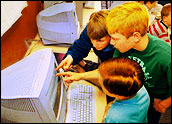
In this year’s election, around 40 million people cast their votes digitally instead of by paper. For many, this was a relief because it meant avoiding discussions over hanging chads. But some computer experts warn of grave problems with electronic voting, making one wonder if technology makes voting better or worse.
The potential problems with digital voting run the gamut from reliability issues and software bugs to hacking and easy election tampering. For instance, during this election, there have been a small number of complaints that voting machines were actually changing the candidates voters chose without their consent.
“We’re getting a number of cases where people are calling saying their votes got changed on the review screen. That’s been the primary machine issue that’s going on,” said Matthew Zimmerman, an attorney with the Electronic Frontier Foundation.
Securing the E-Vote
One way to make digital systems more reliable is to add a paper backup so that voters can compare their paper printout to the way they actually voted. They can then place the printout in a box and it can be re-counted if there are any failures or questions. But some states, like Maryland, have rejected paper back-ups, and other states, like Nevada, are using them but facing paper jams and other issues.
Many smart computer scientists have devoted their time to thinking about the problems arising from new voting technologies, giving one hope that the problems will be solved in the not-so-distant future. And while technical glitches have led some to call for a return to paper ballots, the truth is that voter fraud, mis-counting of ballots, and other issues have been around as long as the vote.
Stories of bags of ballots floating in the river are commonplace, and no matter what the system, human error is hard to avoid. For instance, in the last presidential election, because of human error, one optical scanning system actually deleted votes for Al Gore, giving him minus 16,022 votes. Apparently, someone uploaded a faulty memory card to the county server after workers had already uploaded the real precinct results from another card. But while technology creates some unique issues, it also has benefits.
Consider the way that voters might use technology to inform their voting decisions. Most people don’t have the time to educate themselves about every issue and every political race. In the past, they relied on things like party affiliation, endorsements, or prominent people siding for or against an issue.
Voter Information
With the advent of the Internet, it is possible for trusted interest groups to efficiently and cheaply collect and distribute information to individuals about who and what they should vote for. Let’s look farther into the future, to a day where Americans vote from home. It could be possible for groups, such as the American Civil Liberties Association or the National Rifle Association, to simply let users download a small program that places their recommended votes into an electronic ballot form which can then be reviewed by voters.
With all the potential problems that could surface with digital voting, there are even more that could occur with digital recommendations. But the efficiency gains in both systems are worth striving towards. Consider that in this election and others since the late 1990s, people voting by absentee ballot have had an advantage over others in that, as they were voting, they could look up any candidates or issues they didn’t recognize on the Internet. Democracy might very well be enhanced if everyone had that option by virtue of the process.
In this election, there were a lot of things that could have gone wrong, but in the end people for the most part were able to manage technology. There were no huge digital breakdowns, indicating that while there are potential problems with digital voting systems, America seems to be working out the kinks.
If technology makes it easier to gather and distribute information while protecting against security breaches, technology is a boon. However, technology is only as good as the humans that implement and use it. Whether technology ultimately makes voting better or worse depends on the people themselves.
Sonia Arrison, a TechNewsWorld columnist, is director of Technology Studies at the California-based Pacific Research Institute.





















































